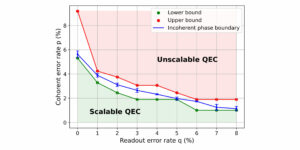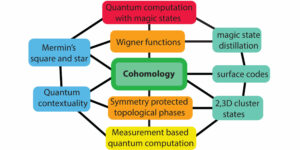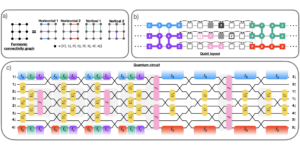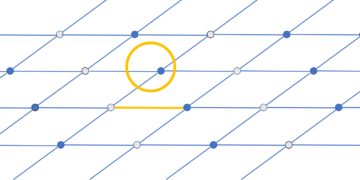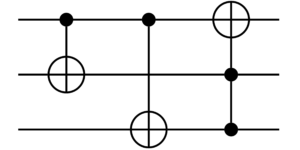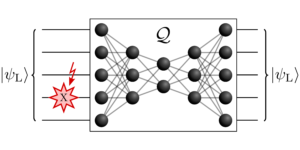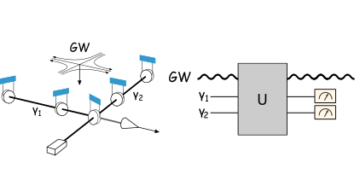Martin A. Fisher School of Physics, Brandeis University, Waltham, MA 02453, USA
Find this paper interesting or want to discuss? Scite or leave a comment on SciRate.
Abstract
Motivated by the ground state structure of quantum models with all-to-all interactions such as mean-field quantum spin glass models and the Sachdev-Ye-Kitaev (SYK) model, we propose a tensor network architecture which can accomodate volume law entanglement and a large ground state degeneracy. We call this architecture the non-local renormalization ansatz (NoRA) because it can be viewed as a generalization of MERA, DMERA, and branching MERA networks with the constraints of spatial locality removed. We argue that the architecture is potentially expressive enough to capture the entanglement and complexity of the ground space of the SYK model, thus making it a suitable variational ansatz, but we leave a detailed study of SYK to future work. We further explore the architecture in the special case in which the tensors are random Clifford gates. Here the architecture can be viewed as the encoding map of a random stabilizer code. We introduce a family of codes inspired by the SYK model which can be chosen to have constant rate and linear distance at the cost of some high weight stabilizers. We also comment on potential similarities between this code family and the approximate code formed from the SYK ground space.
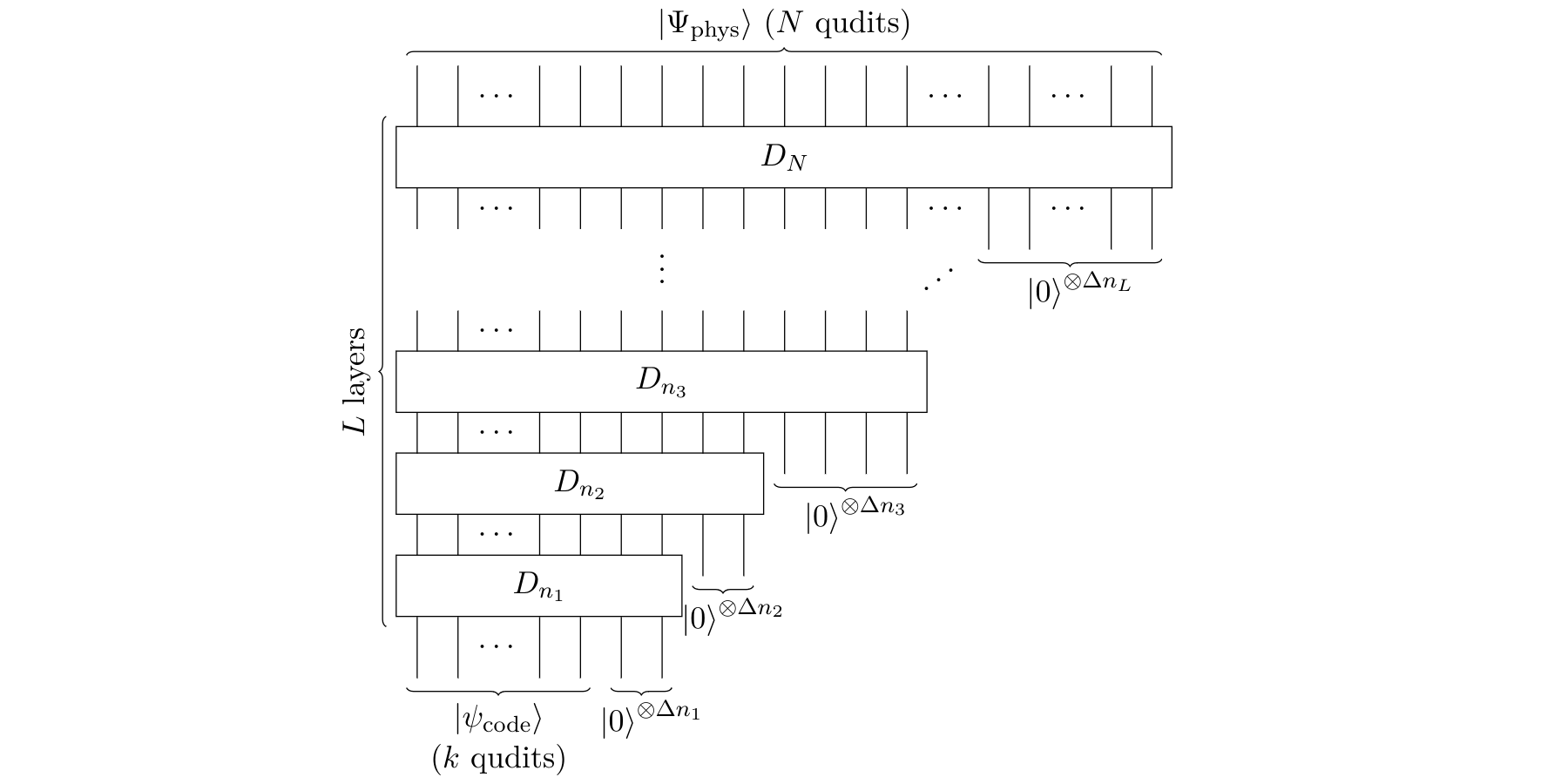
Featured image: Basic architecture of the proposed NoRA tensor network ansatz. A code word $lvertpsi_{textrm{code}}rangle$ consisting of $n_0 equiv k$ (logical) “ground-state” qudits is embedded as $lvertPsi_{textrm{phys}}rangle$ in the (physical) ground space of the $d^N$-dimensional many-body Hilbert space by the means of $L$ layers of some given depth $D$ quantum circuits. For each layer $1 leq ell leq L$ the circuit $D_{ell}$ acts on the $n_{ell – 1}$ qudit output from the previous layer and an additional $Delta n_{ell}$ new ancillary “thermal” qudits initialized in state $lvert 0rangle$. We stress that the layer circuits $D_ell$ do not have to respect locality structure depicted by the 1d arrangement of qudit lines.
Bettaque, V. (2023). Talk 110 – NoRA: A Tensor Network Ansatz for Volume-Law Entangled Equilibrium States of Highly Connected Hamiltonians. Perimeter Institute.
Popular summary
► BibTeX data
► References
[1] Román Orús. “Tensor networks for complex quantum systems”. Nature Reviews Physics 1, 538–550 (2019).
https://doi.org/10.1038/s42254-019-0086-7
[2] M. Fannes, B. Nachtergaele, and R. F. Werner. “Finitely correlated states on quantum spin chains”. Communications in Mathematical Physics 144, 443–490 (1992).
https://doi.org/10.1007/BF02099178
[3] Ulrich Schollwöck. “The density-matrix renormalization group in the age of matrix product states”. Annals of Physics 326, 96–192 (2011).
https://doi.org/10.1016/j.aop.2010.09.012
[4] Reza Haghshenas, Johnnie Gray, Andrew C. Potter, and Garnet Kin-Lic Chan. “Variational Power of Quantum Circuit Tensor Networks”. Physical Review X 12, 011047 (2022).
https://doi.org/10.1103/PhysRevX.12.011047
[5] Isaac H. Kim and Brian Swingle. “Robust entanglement renormalization on a noisy quantum computer” (2017). arxiv:1711.07500.
arXiv:1711.07500
[6] F. Verstraete, J. J. García-Ripoll, and J. I. Cirac. “Matrix Product Density Operators: Simulation of Finite-Temperature and Dissipative Systems”. Physical Review Letters 93, 207204 (2004).
https://doi.org/10.1103/PhysRevLett.93.207204
[7] Brian Swingle and John McGreevy. “Renormalization group constructions of topological quantum liquids and beyond”. Physical Review B 93, 045127 (2016).
https://doi.org/10.1103/PhysRevB.93.045127
[8] G. Evenbly and G. Vidal. “Tensor Network Renormalization Yields the Multiscale Entanglement Renormalization Ansatz”. Physical Review Letters 115, 200401 (2015).
https://doi.org/10.1103/PhysRevLett.115.200401
[9] Bartłomiej Czech, Glen Evenbly, Lampros Lamprou, Samuel McCandlish, Xiao-liang Qi, James Sully, and Guifré Vidal. “Tensor network quotient takes the vacuum to the thermal state”. Physical Review B 94, 085101 (2016).
https://doi.org/10.1103/PhysRevB.94.085101
[10] Brian Swingle, John McGreevy, and Shenglong Xu. “Renormalization group circuits for gapless states”. Physical Review B 93, 205159 (2016).
https://doi.org/10.1103/PhysRevB.93.205159
[11] Jutho Haegeman, Brian Swingle, Michael Walter, Jordan Cotler, Glen Evenbly, and Volkher B. Scholz. “Rigorous Free-Fermion Entanglement Renormalization from Wavelet Theory”. Physical Review X 8, 011003 (2018).
https://doi.org/10.1103/PhysRevX.8.011003
[12] Alexander Novikov, Mikhail Trofimov, and Ivan Oseledets. “Exponential Machines” (2017). arxiv:1605.03795.
arXiv:1605.03795
[13] E. Miles Stoudenmire and David J. Schwab. “Supervised Learning with Quantum-Inspired Tensor Networks” (2017). arxiv:1605.05775.
arXiv:1605.05775
[14] Ding Liu, Shi-Ju Ran, Peter Wittek, Cheng Peng, Raul Blázquez García, Gang Su, and Maciej Lewenstein. “Machine learning by unitary tensor network of hierarchical tree structure”. New Journal of Physics 21, 073059 (2019).
https://doi.org/10.1088/1367-2630/ab31ef
[15] Zhao-Yu Han, Jun Wang, Heng Fan, Lei Wang, and Pan Zhang. “Unsupervised Generative Modeling Using Matrix Product States”. Physical Review X 8, 031012 (2018).
https://doi.org/10.1103/PhysRevX.8.031012
[16] William Huggins, Piyush Patil, Bradley Mitchell, K. Birgitta Whaley, and E. Miles Stoudenmire. “Towards quantum machine learning with tensor networks”. Quantum Science and Technology 4, 024001 (2019).
https://doi.org/10.1088/2058-9565/aaea94
[17] Joseph Tindall, Amy Searle, Abdulla Alhajri, and Dieter Jaksch. “Quantum physics in connected worlds”. Nature Communications 13, 7445 (2022).
https://doi.org/10.1038/s41467-022-35090-y
[18] Amy Searle and Joseph Tindall. “Thermodynamic limit of spin systems on random graphs”. Physical Review Research 6, 013011 (2024).
https://doi.org/10.1103/PhysRevResearch.6.013011
[19] Chunxiao Liu, Xiao Chen, and Leon Balents. “Quantum entanglement of the Sachdev-Ye-Kitaev models”. Physical Review B 97, 245126 (2018).
https://doi.org/10.1103/PhysRevB.97.245126
[20] Yichen Huang and Yingfei Gu. “Eigenstate entanglement in the Sachdev-Ye-Kitaev model”. Physical Review D 100, 041901 (2019).
https://doi.org/10.1103/PhysRevD.100.041901
[21] G. Vidal. “Entanglement Renormalization”. Physical Review Letters 99, 220405 (2007).
https://doi.org/10.1103/PhysRevLett.99.220405
[22] G. Vidal. “Class of Quantum Many-Body States That Can Be Efficiently Simulated”. Physical Review Letters 101, 110501 (2008).
https://doi.org/10.1103/PhysRevLett.101.110501
[23] G. Evenbly and G. Vidal. “Class of Highly Entangled Many-Body States that can be Efficiently Simulated”. Physical Review Letters 112, 240502 (2014).
https://doi.org/10.1103/PhysRevLett.112.240502
[24] Alberto Peruzzo, Jarrod McClean, Peter Shadbolt, Man-Hong Yung, Xiao-Qi Zhou, Peter J. Love, Alán Aspuru-Guzik, and Jeremy L. O’Brien. “A variational eigenvalue solver on a photonic quantum processor”. Nature Communications 5, 4213 (2014).
https://doi.org/10.1038/ncomms5213
[25] Jarrod R. McClean, Jonathan Romero, Ryan Babbush, and Alán Aspuru-Guzik. “The theory of variational hybrid quantum-classical algorithms”. New Journal of Physics 18, 023023 (2016).
https://doi.org/10.1088/1367-2630/18/2/023023
[26] Subir Sachdev and Jinwu Ye. “Gapless spin-fluid ground state in a random quantum Heisenberg magnet”. Physical Review Letters 70, 3339–3342 (1993).
https://doi.org/10.1103/PhysRevLett.70.3339
[27] Alexei Kitaev. “A simple model of quantum holography” (2015).
[28] Joseph Polchinski and Vladimir Rosenhaus. “The spectrum in the Sachdev-Ye-Kitaev model”. Journal of High Energy Physics 2016, 1 (2016).
https://doi.org/10.1007/JHEP04(2016)001
[29] Juan Maldacena and Douglas Stanford. “Remarks on the Sachdev-Ye-Kitaev model”. Physical Review D 94, 106002 (2016).
https://doi.org/10.1103/PhysRevD.94.106002
[30] Arijit Haldar, Omid Tavakol, and Thomas Scaffidi. “Variational wave functions for Sachdev-Ye-Kitaev models”. Physical Review Research 3, 023020 (2021).
https://doi.org/10.1103/PhysRevResearch.3.023020
[31] Brian Swingle. “Entanglement renormalization and holography”. Physical Review D 86, 065007 (2012).
https://doi.org/10.1103/PhysRevD.86.065007
[32] Fernando Pastawski, Beni Yoshida, Daniel Harlow, and John Preskill. “Holographic quantum error-correcting codes: Toy models for the bulk/boundary correspondence”. Journal of High Energy Physics 2015, 149 (2015).
https://doi.org/10.1007/JHEP06(2015)149
[33] J. Molina-Vilaplana and J. Prior. “Entanglement, tensor networks and black hole horizons”. General Relativity and Gravitation 46, 1823 (2014).
https://doi.org/10.1007/s10714-014-1823-y
[34] A. Jahn, M. Gluza, F. Pastawski, and J. Eisert. “Holography and criticality in matchgate tensor networks”. Science Advances 5, eaaw0092 (2019).
https://doi.org/10.1126/sciadv.aaw0092
[35] Arpan Bhattacharyya, Ling-Yan Hung, Yang Lei, and Wei Li. “Tensor network and (p-adic) AdS/CFT”. Journal of High Energy Physics 2018, 139 (2018).
https://doi.org/10.1007/JHEP01(2018)139
[36] Ning Bao, Geoffrey Penington, Jonathan Sorce, and Aron C. Wall. “Beyond toy models: Distilling tensor networks in full AdS/CFT”. Journal of High Energy Physics 2019, 69 (2019).
https://doi.org/10.1007/JHEP11(2019)069
[37] Alexander Jahn and Jens Eisert. “Holographic tensor network models and quantum error correction: A topical review”. Quantum Science and Technology 6, 033002 (2021).
https://doi.org/10.1088/2058-9565/ac0293
[38] Alexander Jahn, Zoltán Zimborás, and Jens Eisert. “Tensor network models of AdS/qCFT”. Quantum 6, 643 (2022).
https://doi.org/10.22331/q-2022-02-03-643
[39] Lin Chen, Haochen Zhang, Kaixin Ji, Ce Shen, Ruoshui Wang, Xiangdong Zeng, and Ling-Yan Hung. “Exact Holographic Tensor Networks – Constructing CFT$_D$ from TQFT$_{D+1}$” (2022). arxiv:2210.12127.
arXiv:2210.12127
[40] Troy J. Sewell, Christopher David White, and Brian Swingle. “Thermal Multi-scale Entanglement Renormalization Ansatz for Variational Gibbs State Preparation” (2022). arxiv:2210.16419.
arXiv:2210.16419
[41] Daniel Gottesman. “Stabilizer Codes and Quantum Error Correction” (1997). arxiv:quant-ph/9705052.
arXiv:quant-ph/9705052
[42] A. R. Calderbank and Peter W. Shor. “Good quantum error-correcting codes exist”. Physical Review A 54, 1098–1105 (1996).
https://doi.org/10.1103/PhysRevA.54.1098
[43] R. Gallager. “Low-density parity-check codes”. IRE Transactions on Information Theory 8, 21–28 (1962).
https://doi.org/10.1109/TIT.1962.1057683
[44] Nikolas P. Breuckmann and Jens Niklas Eberhardt. “Quantum Low-Density Parity-Check Codes”. PRX Quantum 2, 040101 (2021).
https://doi.org/10.1103/PRXQuantum.2.040101
[45] Pavel Panteleev and Gleb Kalachev. “Asymptotically Good Quantum and Locally Testable Classical LDPC Codes” (2022). arxiv:2111.03654.
arXiv:2111.03654
[46] Yotam Dikstein, Irit Dinur, Prahladh Harsha, and Noga Ron-Zewi. “Locally testable codes via high-dimensional expanders” (2020). arxiv:2005.01045.
arXiv:2005.01045
[47] Irit Dinur, Min-Hsiu Hsieh, Ting-Chun Lin, and Thomas Vidick. “Good Quantum LDPC Codes with Linear Time Decoders” (2022). arxiv:2206.07750.
arXiv:2206.07750
[48] Ting-Chun Lin and Min-Hsiu Hsieh. “Good quantum LDPC codes with linear time decoder from lossless expanders” (2022). arxiv:2203.03581.
arXiv:2203.03581
[49] Shouzhen Gu, Christopher A. Pattison, and Eugene Tang. “An efficient decoder for a linear distance quantum LDPC code” (2022). arxiv:2206.06557.
arXiv:2206.06557
[50] Anurag Anshu, Nikolas P. Breuckmann, and Chinmay Nirkhe. “NLTS Hamiltonians from good quantum codes”. In Proceedings of the 55th Annual ACM Symposium on Theory of Computing. Pages 1090–1096. (2023). arxiv:2206.13228.
https://doi.org/10.1145/3564246.3585114
arXiv:2206.13228
[51] Daniel Gottesman. “The Heisenberg Representation of Quantum Computers” (1998). arxiv:quant-ph/9807006.
arXiv:quant-ph/9807006
[52] Scott Aaronson and Daniel Gottesman. “Improved simulation of stabilizer circuits”. Physical Review A 70, 052328 (2004).
https://doi.org/10.1103/PhysRevA.70.052328
[53] Huangjun Zhu. “Multiqubit Clifford groups are unitary 3-designs”. Physical Review A 96, 062336 (2017).
https://doi.org/10.1103/PhysRevA.96.062336
[54] Matthew A. Graydon, Joshua Skanes-Norman, and Joel J. Wallman. “Clifford groups are not always 2-designs” (2021). arxiv:2108.04200.
arXiv:2108.04200
[55] Robert Koenig and John A. Smolin. “How to efficiently select an arbitrary Clifford group element”. Journal of Mathematical Physics 55, 122202 (2014). arxiv:1406.2170.
https://doi.org/10.1063/1.4903507
arXiv:1406.2170
[56] Charles R. Harris, K. Jarrod Millman, Stéfan J. van der Walt, Ralf Gommers, Pauli Virtanen, David Cournapeau, Eric Wieser, Julian Taylor, Sebastian Berg, Nathaniel J. Smith, Robert Kern, Matti Picus, Stephan Hoyer, Marten H. van Kerkwijk, Matthew Brett, Allan Haldane, Jaime Fernández del Río, Mark Wiebe, Pearu Peterson, Pierre Gérard-Marchant, Kevin Sheppard, Tyler Reddy, Warren Weckesser, Hameer Abbasi, Christoph Gohlke, and Travis E. Oliphant. “Array programming with NumPy”. Nature 585, 357–362 (2020).
https://doi.org/10.1038/s41586-020-2649-2
[57] Matt Hostetter. “Galois: A performant NumPy extension for Galois fields” (2020).
[58] A. Yu. Kitaev. “Fault-tolerant quantum computation by anyons”. Annals of Physics 303, 2–30 (2003).
https://doi.org/10.1016/S0003-4916(02)00018-0
[59] Adam R. Brown, Hrant Gharibyan, Henry W. Lin, Leonard Susskind, Larus Thorlacius, and Ying Zhao. “The Case of the Missing Gates: Complexity of Jackiw-Teitelboim Gravity”. Physical Review D 99, 046016 (2019). arxiv:1810.08741.
https://doi.org/10.1103/PhysRevD.99.046016
arXiv:1810.08741
[60] Wenbo Fu, Davide Gaiotto, Juan Maldacena, and Subir Sachdev. “Publisher’s Note: Supersymmetric Sachdev-Ye-Kitaev models [Phys. Rev. D 95, 026009 (2017)]”. Physical Review D 95, 069904 (2017).
https://doi.org/10.1103/PhysRevD.95.069904
[61] Jordan S. Cotler, Guy Gur-Ari, Masanori Hanada, Joseph Polchinski, Phil Saad, Stephen H. Shenker, Douglas Stanford, Alexandre Streicher, and Masaki Tezuka. “Black holes and random matrices”. Journal of High Energy Physics 2017, 118 (2017).
https://doi.org/10.1007/JHEP05(2017)118
[62] Phil Saad, Stephen H. Shenker, and Douglas Stanford. “A semiclassical ramp in SYK and in gravity” (2019). arxiv:1806.06840.
arXiv:1806.06840
[63] Venkatesa Chandrasekaran and Adam Levine. “Quantum error correction in SYK and bulk emergence”. Journal of High Energy Physics 2022, 39 (2022).
https://doi.org/10.1007/JHEP06(2022)039
[64] Stephen P. Jordan and Edward Farhi. “Perturbative gadgets at arbitrary orders”. Physical Review A 77, 062329 (2008).
https://doi.org/10.1103/PhysRevA.77.062329
[65] Sergey Bravyi, Barbara M. Terhal, and Bernhard Leemhuis. “Majorana fermion codes”. New Journal of Physics 12, 083039 (2010).
https://doi.org/10.1088/1367-2630/12/8/083039
[66] Daniel Louis Jafferis and David K. Kolchmeyer. “Entanglement Entropy in Jackiw-Teitelboim Gravity” (2022). arxiv:1911.10663.
arXiv:1911.10663
[67] Mukund Rangamani and Tadashi Takayanagi. “Holographic Entanglement Entropy”. Volume 931 of Lecture Notes in Physics. Springer International Publishing. Cham (2017).
https://doi.org/10.1007/978-3-319-52573-0
[68] D. Gross. “Hudson’s Theorem for finite-dimensional quantum systems”. Journal of Mathematical Physics 47, 122107 (2006). arxiv:quant-ph/0602001.
https://doi.org/10.1063/1.2393152
arXiv:quant-ph/0602001
Cited by
[1] Gregory Bentsen, Phuc Nguyen, and Brian Swingle, “Approximate Quantum Codes From Long Wormholes”, arXiv:2310.07770, (2023).
[2] Francesco Romeo and Alfonso Maiellaro, “Bardeen-Cooper-Schrieffer interaction as an infinite-range Penson-Kolb pairing mechanism”, Physical Review B 109 13, 134509 (2024).
The above citations are from SAO/NASA ADS (last updated successfully 2024-05-27 12:29:38). The list may be incomplete as not all publishers provide suitable and complete citation data.
Could not fetch Crossref cited-by data during last attempt 2024-05-27 12:29:37: Could not fetch cited-by data for 10.22331/q-2024-05-27-1362 from Crossref. This is normal if the DOI was registered recently.
This Paper is published in Quantum under the Creative Commons Attribution 4.0 International (CC BY 4.0) license. Copyright remains with the original copyright holders such as the authors or their institutions.
- SEO Powered Content & PR Distribution. Get Amplified Today.
- PlatoData.Network Vertical Generative Ai. Empower Yourself. Access Here.
- PlatoAiStream. Web3 Intelligence. Knowledge Amplified. Access Here.
- PlatoESG. Carbon, CleanTech, Energy, Environment, Solar, Waste Management. Access Here.
- PlatoHealth. Biotech and Clinical Trials Intelligence. Access Here.
- Source: https://quantum-journal.org/papers/q-2024-05-27-1362/
- :is
- :not
- ][p
- $UP
- 09
- 1
- 10
- 100
- 11
- 118
- 12
- 13
- 14
- 15%
- 16
- 17
- 1800
- 19
- 1996
- 1998
- 20
- 2005
- 2006
- 2008
- 2011
- 2012
- 2014
- 2015
- 2016
- 2017
- 2018
- 2019
- 2020
- 2021
- 2022
- 2023
- 2024
- 22
- 23
- 24
- 25
- 26%
- 27
- 28
- 29
- 30
- 31
- 32
- 33
- 35%
- 36
- 37
- 39
- 40
- 41
- 43
- 49
- 50
- 51
- 53
- 54
- 58
- 60
- 65
- 66
- 67
- 69
- 7
- 70
- 77
- 8
- 9
- 900
- 97
- a
- ability
- Able
- above
- ABSTRACT
- access
- ACM
- acts
- Adam
- addition
- Additional
- advances
- affiliations
- age
- Alexander
- algorithms
- All
- also
- Although
- always
- amy
- an
- analyze
- analyzed
- and
- Andrew
- annual
- applications
- approximate
- arbitrary
- architecture
- ARE
- argue
- Arijit
- aron
- arrangement
- AS
- At
- attempt
- author
- authors
- basic
- basis
- BE
- because
- become
- being
- between
- Beyond
- Black
- Black Hole
- branches
- Break
- Brian
- brown
- but
- by
- call
- called
- CAN
- capture
- case
- chains
- chan
- Charles
- chen
- Cheng
- chosen
- Christopher
- class
- code
- codes
- comment
- Commons
- Communications
- complete
- complex
- complexity
- complicated
- computation
- computer
- computers
- computing
- connected
- Consisting
- constant
- constraints
- constructing
- construction
- copyright
- Cost
- could
- criticality
- Daniel
- data
- David
- del
- depicted
- depth
- detailed
- develop
- different
- discuss
- distance
- do
- douglas
- due
- during
- e
- each
- Edward
- efficient
- efficiently
- either
- element
- embedded
- emergence
- encoding
- energy
- enough
- entanglement
- Equilibrium
- eric
- error
- Errors
- essential
- eugene
- excellent
- exist
- explore
- expressive
- extension
- family
- fan
- Fields
- finding
- For
- form
- formed
- found
- from
- fu
- full
- functions
- further
- future
- Gadgets
- Gang
- Gates
- General
- generative
- given
- glass
- good
- graphs
- gravity
- gray
- gross
- Ground
- Group
- Group’s
- Guy
- harder
- harvard
- Have
- henry
- here
- hierarchical
- High
- highly
- holders
- Hole
- Holes
- holographic
- holography
- Horizons
- However
- HTTPS
- huang
- hung
- Hybrid
- hybrid quantum-classical
- i
- if
- image
- in
- information
- inspired
- Institute
- institutions
- interacting
- interaction
- interactions
- interesting
- International
- introduce
- IT
- ITS
- ivan
- james
- JavaScript
- jeremy
- joel
- John
- Johnnie
- jonathan
- Jordan
- joseph
- joshua
- journal
- juan
- Kim
- large
- large-scale
- Last
- Law
- layer
- layers
- learning
- Leave
- Lecture
- lei
- leonard
- levine
- Li
- License
- like
- LIMIT
- lin
- linear
- lines
- List
- local
- locally
- logical
- Long
- Louis
- love
- machine
- machine learning
- Machines
- magnet
- Making
- many
- map
- mark
- mathematical
- Matrix
- matt
- matthew
- max-width
- May..
- mcclean
- means
- mechanism
- Michael
- mikhail
- missing
- model
- modeling
- models
- Month
- more
- much
- Nature
- network
- networks
- New
- Nguyen
- normal
- note
- Notes
- numpy
- of
- on
- ONE
- open
- opening
- operators
- or
- orders
- original
- Other
- our
- output
- pages
- pairing
- Paper
- parameters
- Paramount
- Peter
- Peterson
- phase
- PHIL
- physical
- Physics
- Pierre
- plato
- Plato Data Intelligence
- PlatoData
- potential
- potentially
- power
- practically
- preparation
- previous
- Prior
- Proceedings
- Processor
- produce
- Product
- Programming
- propose
- proposed
- prospect
- provide
- published
- publisher
- publishers
- Publishing
- Qi
- Quantum
- Quantum Computer
- quantum computers
- quantum error correction
- quantum machine learning
- quantum systems
- R
- Ralf
- Ramp
- random
- Rate
- recently
- references
- registered
- relativity
- rely
- remaining
- remains
- Removed
- representation
- research
- respect
- resulting
- review
- Reviews
- ROBERT
- Ryan
- s
- SAAD
- School
- Science
- Science and Technology
- scott
- scott aaronson
- sebastian
- select
- Sheppard
- Shor
- similarities
- Simple
- simplified
- simulation
- smith
- some
- Space
- Spatial
- special
- Spectrum
- Spin
- stanford
- State
- States
- Stephen
- Still
- stress
- structure
- Study
- Successfully
- such
- suitable
- Symposium
- system
- Systems
- takes
- Talk
- tang
- Technology
- Tezuka
- that
- The
- The Future
- their
- Them
- theory
- therefore
- thermal
- this
- thomas
- those
- Thus
- time
- Title
- to
- topological quantum
- Transactions
- transitions
- tree
- tyler
- under
- university
- updated
- URL
- using
- Vacuum
- van
- various
- version
- via
- volume
- W
- Wall
- wang
- want
- warren
- was
- Wave
- we
- weight
- which
- while
- white
- wider
- william
- with
- Word
- Work
- world’s
- X
- xiao
- Ye
- year
- yet
- yields
- YING
- zephyrnet
- Zhao






